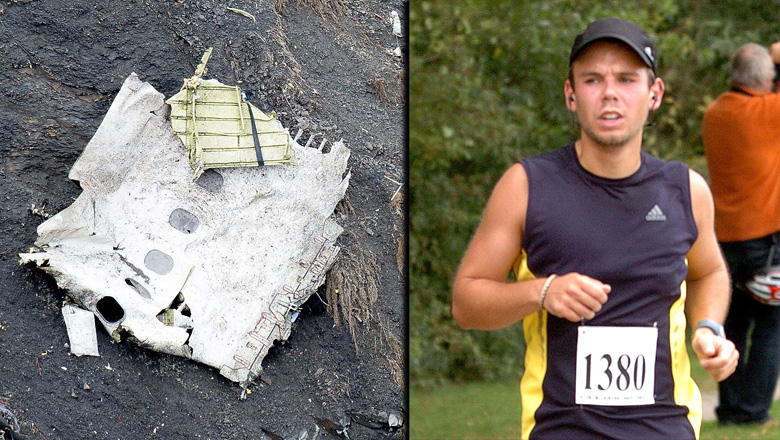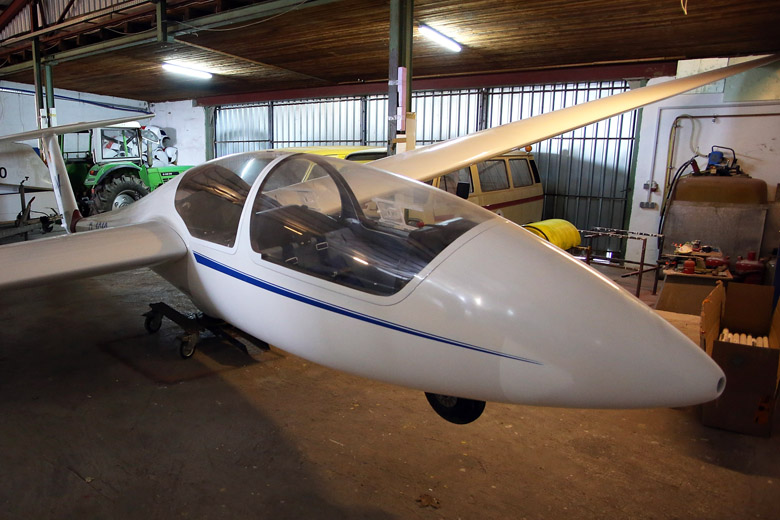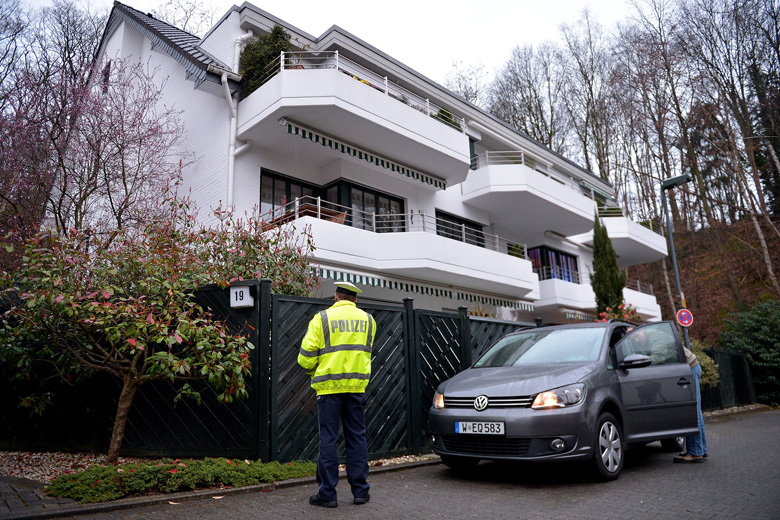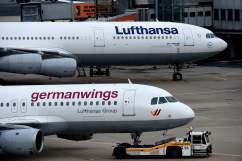
Andreas Lubitz (right) and the wreckage of Germanwings Flight 9525. (Ministere de l’Interieur via Getty)
Andreas Lubitz was the Germanwings co-pilot who locked his captain out of the cockpit and deliberately flew Flight 9525 into the side of a mountain, killing all 150 people onboard. Officials on Thursday made the shocking announcement that the March 24 crash in the French Alps was not an accident but a deliberate act of mass murder.
Here’s what you need to know about Lubitz and his role in this horrific aviation disaster:
1. He Hijacked the Cockpit With ‘Intention to Destroy the Plane’ & Breathed Calmly as the Airliner Went Down
Officials say the 27-year-old Lubitz locked out the experienced pilot, Captain Patrick Sonderheimer, from the cockpit when Sonderheimer went to use the restroom. Lubitz then programmed the plane’s descent.
Information released by FlightRadar24 shows when the reprogramming occurred. According to the playback video, between 9:30:52 a.m. and 09:30:55 a.m. UTC the autopilot was manually changed from 38,000 feet to 100 feet. Nine seconds later the aircraft started to descend.
You can watch the animation here.
Public Prosecutor of Marseille Brice Robin said Thursday that Lubitz’s “intention was to destroy the plane.”
The airliner hit a mountainside at 430 mph.
Robin, who is handling the case, said Lubitz had no criminal record and was not on any terrorist watch list.

The recovered black box from Germanwings Flight 9525.
Lubitz can be heard calmly breathing on the black box recording as Flight 9525 descended and crashed in the French Alps. The pilot is heard pounding frantically on the door, and just before impact passengers scream in horror.
One hundred fifty people were killed in the crash, including three Americans. The Americans have been named as Yvonne and Emily Selke, a mother and daughter from Nokesville, Virginia, and Robert Oliver Calvo, a Spanish-born U.S. citizen.
The nationalities of the other victims have ranged from primarily German and Spanish, to English, Australian and Colombian.
2. He Suffered From an Illness, Hid It From His Employer & Destroyed Doctor’s Notes That Said He Was Unfit to Fly

Andreas Lubitz poses at the Golden Gate Bridge in his Facebook profile photo.
A search of Lubitz’s apartment in Dusseldorf found ripped-up medical leave notes that indicate he suffered from an illness and was unfit to fly on the day of the crash.
Prosecutors in Dusseldorf said Friday that it appears he was hiding the illness from his employer:
Documents with medical contents were confiscated that point towards an existing illness and corresponding treatment by doctors.
The fact there are sick notes saying he was unable to work, among other things, that were found torn up, which were recent and even from the day of the crime, support the assumption based on the preliminary examination that the deceased hid his illness from his employer and his professional colleagues.
Police also searched Lubitz’s parent’s home and left with boxes of evidence.
The Dusseldorf prosecutors said they found no suicide note, no confession, and no indication of political or religious motivation. They did not specify the nature of the illness — whether it was physical or mental.
On Thursday, a woman identified as the mother of Lubitz’s classmate told the Frankfurter Zeitung that he suffered a breakdown in the past: “Apparently, he had a burnout, depression.”
The BBC reports that a local hospital where Lubitz was recently treated denies the treatment was for depression:
Duesseldorf University Clinic says Mr Lubitz had been receiving treatment there — but denies that this was for depression, contrary to some media reports. The clinic says it cannot give further details because of rules governing patient confidentiality.
But The Wall Street Journal, citing a “person familiar with the investigation,” reports that Lubitz was being treated for depression and “had been excused from work by his treating neuropsychologist for a period that included the day of the crash … but decided to ignore the advice and reported to work.”
Lufthansa CEO Carsten Spohr said Thursday that Lubitz was “100 percent fit to fly” but acknowledged that he “took a break in his training six years ago. … He took a several-months break for reasons I do not know.”
Lubitz’s classmate’s mother added that Lubitz was a “good boy” with a “good family background” and, speculating on why he crashed the plane, said, “I can imagine the whole thing as a knee-jerk reaction. It could not have been planned, though, it really was like a shooting spree.”
3. He Started Flying at Age 14 but Was an Inexperienced Commercial Pilot

The LSC Westerwald airfield, where Andreas Lubitz first learned to fly, is seen on March 27 in Montabaur, Germany. (Getty)
Lubitz first learned to fly as a young teenager, piloting gliders.
LSC Westerwald flight club in Montabaur, of which Lubitz was a member, identified him in a death notice posted on its website:
As a youth, Andreas became a member of the club, he wanted to see his dream of flying fulfilled. He started as a gliding student and managed to become a pilot of the Airbus A320. He succeeded in fulfilling his dream, a dream that he paid for with his life. The members of LSC Westerwald are grieving for Andreas and all the other 149 victims of the catastrophe of March 24, 2015. Our deepest condolences to the relatives. We will not forget Andreas.
The club likely posted the tribute before learning that Lubitz caused the crash.

A glider of the LSC Westerwald airfield, where Andreas Lubitz learned to fly. (Getty)
Lubitz became a Lufthansa trainee after graduating from a rigorous prep school, and he joined Germanwings, Lufthansa’s low-cost airline, in September 2013. He entered the company straight from Lufthansa flight school, having trained in Bremen, Germany, and Phoenix, Arizona.
At the time of the crash, Lubitz had logged just 630 hours of flying time. By contrast, co-pilots flying for U.S. commercial airlines are required to have a minimum of 1,500 hours, per a revised FAA regulation passed in 2013.
Lubitz possessed an FAA-issued private pilot’s license, received in 2012, and an FAA-issued student license, received in 2010.
4. His Fiancee Recently Dumped Him — After He Bought Her an Audi

Andreas Lubitz’s apartment building in Dusseldorf. (Getty)
The Daily Express reports that Lubitz had recently been dumped by his fiancee and was “struggling to cope.”
The German magazine Focus reports that Lubitz recently ordered two new Audi automobiles at a local dealership — one for himself and one for his fiancee — but later canceled the order on one of them.
Lubitz lived part-time with his parents in the famous Rhineland region of Germany, about halfway between Cologne and Frankfurt. He also had an apartment in Dusseldorf, the planned destination of the doomed flight, where he lived with his fiancee.
LSC Westerwald flight club member Peter Ruecker told the AP that Lubitz had a “girlfriend.” He added that Lubitz visited the club last fall to renew his glider’s license and “seemed very enthusiastic … I can’t remember anything where something wasn’t right.”
Lubitz’s family had joined victims’ families in France but were separated from the others after learning he had deliberately caused the crash — receiving the shocking news just before it was announced to the world.
5. An Article Calling Lubitz ‘a Positive Example’ Has Been Called a ‘Fake’

A 2013 mention in the Aviation Business Gazette notes Lubitz’s inclusion in the FAA Airmen Certification Database.
The website Aviation Business Gazette included a mention of Lubitz in September 2013:
The Federal Aviation Administration (FAA) is recognizing Andreas Guenter Lubitz with inclusion in the prestigious FAA Airmen Certification Database.
The database, which appears on the agency’s website at www.faa.gov, names Lubitz and other certified pilots who have met or exceeded the high educational, licensing and medical standards established by the FAA.
But Newsweek points out that the Aviation Business Gazette is a dubious website that affords bogus praise where none is due:
Bizarrely, the website in fact has an identical article for every member of the FAA’s Airmen Certification Database, published on the same date, 18 September 2013, as seen in the screenshot below, indicating that the FAA did not single out Lubitz for praise.
On the Pilots of America forum, earlier this year, puzzled pilots discussed their mysterious inclusion in the “vanity” website, which apparently mines public FAA data and turns it into a pile of identical, overblown articles with various pilot’s names inserted:
Is this some type of spam website or scam or something?
A friend found this while searching for my name (cyber-stalking I’m sure).
Click on any of the names, and you get an “article” about how the FAA “recognizes” that person with a prestigious pilot’s license. No more mention is made about that person past the 2nd paragraph, where it’s a generic press release-type article with a quote from the Secretary of Transportation and some other info about the ATP and such. Then at the end it shows the FAA database information on that person, like home address.
Click on any name and it’s exactly the same. You can even manually navigate “up” a directory and go to:
http://aviation-business-gazette.com/A26/
Where you get more subdirectories.
Yes, I am one of the names on here, but I have no idea how many names are listed. I don’t see any way to “search” the listings either (not sure why I’d want to though).
It reminds me of those novelty/vanity magazine covers – People Magazine’s Man of the Year issue with your picture on it, that kind of thing.
An earlier version of this article, as well as numerous mentions by reporters from major news outlets, cited the article without drawing attention to its dubious nature.

